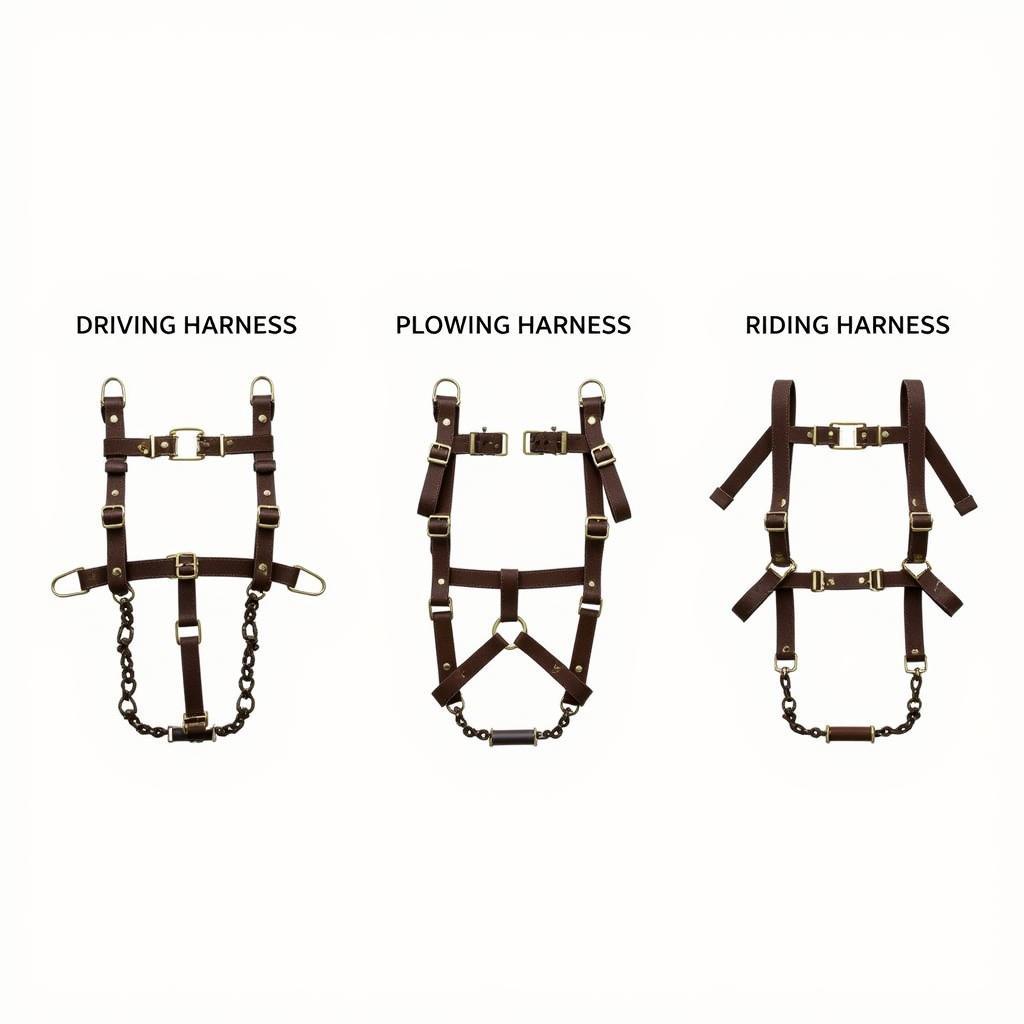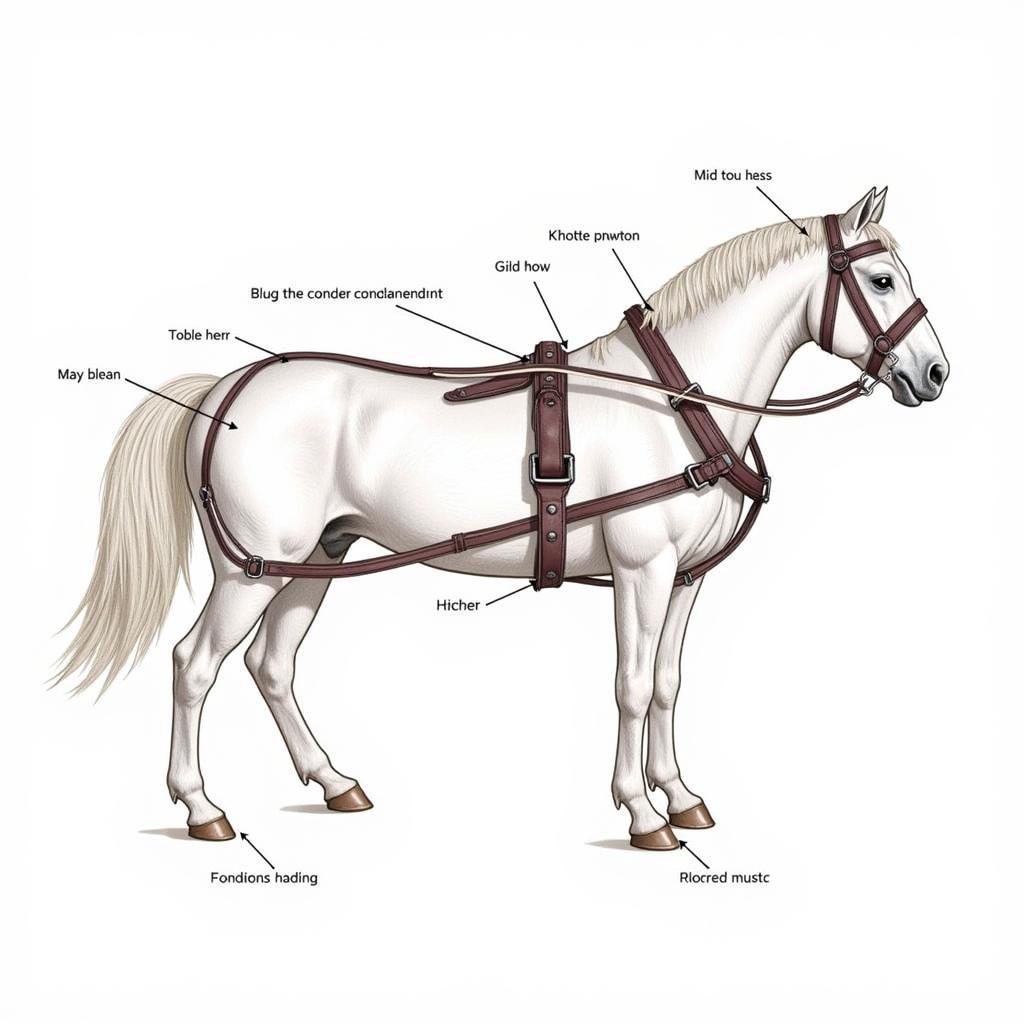Understanding the anatomy of a horse harness can feel like navigating a foreign country. But don’t worry, every seasoned equestrian was once a beginner, too! This comprehensive guide dives deep into the world of Horse Harness Hardware Parts, equipping you with the knowledge to choose the right gear and harness your equine partner safely and comfortably.
 Different Horse Harness Types
Different Horse Harness Types
Deconstructing the Harness: Essential Hardware Parts
Before we delve into specific parts, it’s crucial to understand that harnesses vary significantly depending on their intended use – driving, riding, or work. However, several key hardware components remain consistent:
1. Bit: The Heart of Communication
The bit rests inside the horse’s mouth and serves as the primary tool for communication between horse and handler. Bits come in various materials like stainless steel, copper, and synthetic materials, each influencing the horse’s acceptance and responsiveness.
Expert Insight: “Choosing the right bit is crucial,” says Sarah Williams, a certified equine behaviorist. “A poorly fitted or overly harsh bit can cause discomfort, pain, and even behavioral issues.”
2. Reins: Guiding the Way
Attached to the bit, reins provide the rider or driver with control over the horse’s direction and speed. Reins are typically made from leather, nylon, or synthetic blends and can be found in various styles, widths, and lengths to suit different disciplines and rider preferences.
3. Bridle: Holding It All Together
The bridle is the headstall that holds the bit in place and provides attachment points for the reins. Bridles are usually made from leather or nylon and come in a wide range of styles, each designed to fit the horse’s head comfortably and securely.
4. Breastplate or Breastcollar: Preventing Slippage
As the name suggests, this piece sits across the horse’s chest, preventing the harness from slipping backward. Breastplates are particularly crucial in driving and heavy work, ensuring the harness remains in its optimal position.
5. Saddle (For Riding Harnesses): The Rider’s Seat
Riding harnesses include a saddle, providing a secure and balanced seat for the rider. Saddles are crafted from various materials, with leather being the most traditional. The saddle’s fit is paramount for both horse and rider comfort, making professional saddle fitting essential.
6. Girth: Securing the Saddle
The girth is a wide strap that fastens around the horse’s belly, securing the saddle in place. Girths are commonly made from leather, neoprene, or synthetic materials and must be adjusted correctly to ensure the saddle remains stable without causing discomfort.
7. Traces: Transferring Power
Primarily used in driving and work harnesses, traces connect the harness to the vehicle or implement being pulled. They are typically made from strong, durable materials like leather or nylon webbing and are designed to distribute the load evenly across the horse’s body.
8. Backband and Crupper: Maintaining Position
The backband sits across the horse’s back, providing an anchor point for the traces and other harness components. The crupper, a strap that loops under the horse’s tail, prevents the harness from shifting forward.
 Essential Hardware of a Driving Harness
Essential Hardware of a Driving Harness
Selecting the Right Hardware: Factors to Consider
Choosing the appropriate harness hardware is about more than just aesthetics; it directly impacts your horse’s comfort, performance, and well-being. Consider these crucial factors:
- Harness Purpose: Different disciplines require specific harness designs and hardware.
- Horse Size and Conformation: Just like with shoes, harnesses need to fit perfectly.
- Material and Quality: Opt for durable, high-quality materials that can withstand wear and tear.
- Maintenance Requirements: Consider the ease of cleaning and maintenance when selecting materials.
- Budget: Horse harness hardware can range significantly in price, so set a budget beforehand.
Conclusion: Equipping Your Equine Partner for Success
A deep understanding of horse harness hardware is fundamental for any horse owner. By carefully selecting each component based on its intended use, your horse’s individual needs, and the principles of comfort and safety, you create a harmonious and effective partnership with your equine companion. Remember, a well-fitted harness is an investment in your horse’s well-being and your peace of mind.
For personalized advice on choosing the perfect horse harness hardware, don’t hesitate to contact us at Justus Horses USA. Call us at 0772127271, email us at [email protected], or visit us at QGM2+WX2, Vị Trung, Vị Thuỷ, Hậu Giang, Việt Nam. Our dedicated team of equine experts is available 24/7 to answer your questions and guide you towards the best choices for your equine partner.